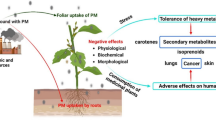Abstract
The studies on the concentration of total nitrogen, phosphorus, sulphur, chlorine, iodine and boron as well as on the thermal decomposition of commercial raw plant materials used in medicine were performed. The 50 independent samples of herbs originating from 25 medicinal plant species collected in 1986–92 were analysed. The content of non-metallic elements was determined spectrophotometrically after previous mineralization of plant sample. The thermal decomposition was performed using the derivatograph with the application of 100 mg samples and heating rate of 5°C min−1. In order to obtain more clear classification of the analysed plant materials principal component analysis (PCA) was applied. Interpretation of PCA results for two databases (non-metals and thermoanalytical data sets) allows to state, that samples of herbs from the same plant species in majority of cases are characterized by similar elemental composition and similar course of their thermal decomposition. In this way the differences in general chemical composition of medicinal plants raw materials can be determined.
Similar content being viewed by others
References
J. Volak and J. Stodola, Rośliny lecznicze (Medicinal plants), PWRiL, Warszawa 1986.
B. Beldowska and J. Guzewska, Rośliny lecznicze, opis, zbiór, zastosowanie (Medicinal plants, description, harvest, application), IWZZ, Warszawa 1987.
C. Simionescu, A. Cernátescu-Asandei, P. Andriescu and C. S. Papadopol, Cellulose Chem. Technol., 11 (1977) 141.
M. Tomassctti, L. Campanella and R. Tomellini, Thermochim. Acta, 117 (1987) 297.
F. Shafizadeh, P. P. S. Chin and W. F. DeGroot, Forest Sci., 23 (1977) 81.
F. Shafizadeh, AIChE Symp. Ser., 74 (1978) 76.
S. Cebulak and M. Pliński, Oceanologia, 38 (1996) 99.
M. Wesołowski and P. Konieczyńiski, Orient. J. Chem., 11 (1995) 1.
M. Wesołowski and P. Konieczyński, Orient. J. Chem., 11 (1995) 115.
B. R. Kowalski, Anal. Chem., 52 (1980) 112R.
R. E. Aries, D. P. Lidiard and R.A. Spragg, Chemistry in Britain, 9 (1991) 821.
M. Wesołowski and P. Konieczyński, Chem. Anal. (Warszawa), 41 (1996) 377.
S. Kohlmünzer, Farmakognozja (Pharmacognosy), 4th ed., PZWL, Warszawa 1993.
Author information
Authors and Affiliations
Rights and permissions
About this article
Cite this article
Wesołowski, M., Konieczyński, P. Relation Between Thermal Decomposition of Medicinal Herbs and their Non-Metals Concentration. Journal of Thermal Analysis and Calorimetry 54, 219–226 (1998). https://doi.org/10.1023/A:1010145708773
Issue Date:
DOI: https://doi.org/10.1023/A:1010145708773




